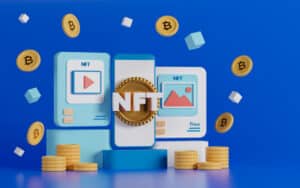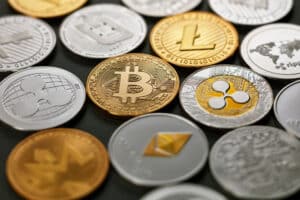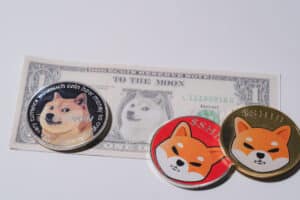Ethereum was the first blockchain to enable the development of decentralized apps (dApps) on its network. They give users more control over the data managed by the dApps, which a consensus model operates on the network. Once the growing dApps popularity caused congestion on the blockchain, the users were made to pay higher fees to incentivize miners for processing their transactions.
Hence, Ethereum is currently implementing its Ethereum 2.0 update, which will change the network’s consensus model from proof of work to proof of stake. This is expected to increase the number of transactions per second (tps) the network can handle, reduce congestion, and significantly lower gas fees.
Leading projects on Ethereum
At the moment, most projects on this blockchain serve decentralized finance (DeFi), aiming to extend the use of crypto tokens from simple transactions to more complex finance use cases, such as lending and derivatives. On the other hand, Ethereum is an open-source platform, and thus, any projects built on it may be experimental or outright scams. For that reason, due diligence is of paramount importance before investing in any of these projects. That being said, here are the leading dApps on the Ethereum blockchain.
1. MakerDAO
Maker is a token whose purpose is to create a stable Ethereum token named DAI, which is pegged to the value of one dollar. This is meant to solve the problem of instability and price fluctuations of cryptocurrencies, which plagues most crypto transactions.
This dApp works through overcollaterization, meaning users supply crypto tokens which are then locked up in smart contracts. In exchange, they borrow freshly-minted DAI tokens. In effect, the crypto they supply acts as collateral, and the smart contracts play the role of traditional loan sharks.
The DAI they receive can then be used to transfer value on the Ethereum blockchain. It is an especially useful medium of payment since it has a stable value of 1 USD. This means its value cannot fluctuate in the middle of a transaction. As a result, such a token is aptly named a stablecoin.
If users wish to recover the crypto assets they provided as collateral, they must pay back their DAI loans plus any interest or fees accrued.
2. Uniswap
Uniswap is a decentralized exchange (DEX) hosted on the Ethereum network. Since its launch in 2018, it has gone on to become the largest of its kind on the blockchain, dwarfing other DEXs on the network, such as Curve and SushiSwap. On it, users can exchange cryptocurrencies without an intermediary. Its native token, UNI, allows holders to participate in governance decisions, such as voting for any developments on the platform.
Uniswap runs the automated market maker model (AMM), where users supply the ERC-20 tokens to the liquidity pools on the exchange. The exchange then utilizes algorithms to set these tokens’ prices based on their supply and demand.
Users who supply tokens to liquidity pools earn rewards in return. They also get to enjoy peer-to-peer trading on the platform. What’s more, they can launch their own tokens on Uniswap using the ERC-20 protocol.
This decentralized exchange brings with its perks such as:
- It enables global trade with no border restrictions.
- It ensures the anonymity of involved parties, as no personal details are required on the platform.
- There are no third parties involved in transactions, which reduces the risk of theft or malicious intent.
3. Chainlink
Chainlink is a platform that connects blockchains with external data. Its native coin is called Link, which is an ERC-20 token. By design, this platform is not limited to any one blockchain. It utilizes oracles, which are avenues for bringing real-time data into blockchains. It incentivizes a network of computers worldwide (nodes) to provide real-time data to these oracles. This data may be anything from weather patterns, prices, or even election results. Link is used to pay for services on Chainlink and incentivize nodes to provide accurate data to the oracles.
To understand how it works, think of a blockchain as a computer with no internet access. Though this might isolate it from outside information, it ensures the data within the computer stays secure. Oracles would be like internet access to our computer in this context – they allow the blockchain to access information from external sources. What’s more, the blockchain can also transmit on-chain data to other peers outside the network. Chainlink is thus a collection of these networks (oracles) that link blockchains to each other and other external data sources.
4. Axie Infinity
Axie Infinity is a Pokemon-style game that is built on the Ethereum blockchain. On it, players breed, battle, and trade characters called Axies. These Axies are represented in the form of NFTs, which makes them tradable on exchanges alongside virtual real estate on the game. To resolve the high gas fees synonymous with the Ethereum chain, most of these NFT transactions occur on a sidechain named Ronin.
There are two main tokens utilized in the game. The first is Axie Infinity Shards (AXS). AXS acts as a governance token, which enables holders to vote on developments and other governance protocols of the game. These tokens can be obtained from most major crypto exchange platforms.
The second token is named Small Love Potion (SLP). This token is doled out as a reward for playing Axie Infinity. You can obtain SLP by winning battles against other Axies, or by completing quests on the game. This token is not listed on major exchanges, but you can trade it on DEXs like Uniswap.
5. Aave
This is a platform on which users can lend, borrow and earn interest on the crypto tokens they hold, all within a decentralized environment. On Aave, users can create lending pools that enable them to borrow and lend 17 different tokens. Like other DeFi platforms, they’ll need to post collateral to qualify for a loan. What’s more, these loans are limited to the value of collateral they post.
Lenders are to deposit funds into the lending pools. Borrowers can then take out loans from these pools. To enable this, Aave utilizes two tokens, aTokens, which are given to lenders to enable them to earn interest on their deposits to lending pools, and AAVE, the platform’s native token.
Users who borrow in AAVE are not charged fees. Borrowers who use it as collateral also get a discount on the fees they are charged on taking out loans. They also get to borrow slightly more than other users. You can post collateral in one cryptocurrency and borrow another, which allows you to hold tokens without actually owning them.
The platform also has a flash loans feature, which refers to instantaneous loans that require no collateral. These flash loans must be paid back within the same block they were issued in, plus a 0.09% interest, or else the transaction is canceled, and no funds are remitted to the borrower.
6. Compound
The compound is another platform built on Ethereum on which users can lend and borrow crypto assets. It utilizes its native COMP token, which carries governance privileges. Similar to other DeFi lending platforms, you can borrow or lend a variety of cryptocurrencies on the Ethereum blockchain. The supply and demand of a specific coin determine the interest rates charged to borrowers and those paid out to lenders. The mining of ETH blocks also influences interest rates.
COMP tokens are used to represent the funds a user sends to a lending pool on the platform. For instance, if you deposit USDC into a lending pool, you are assigned an equivalent amount of COMP, which starts accruing annual interest. You can later redeem these COMP tokens plus your accrued interest for the token you deposited. Interest is paid out in the form of the token you staked.
Anyone with staked funds in the Compound lending pool can access loans on any of the compatible tokens. Depositing funds in this pool is just like sending funds to a traditional savings account, while taking loans on Compound works just like loans from a bank, except you need no credit score and there are no middlemen involved.
7. Sushiswap
This is a decentralized exchange (DEX) on the Ethereum network. It originated as a fork from Uniswap, the most popular DEX on the network. It is powered by the SUSHI token and runs on the AMM model. It uses smart contracts to provide liquidity pools, which in turn enable users to trade crypto on the platform in a decentralized manner. However, you cannot trade using fiat currencies on Sushiswap – you can only exchange one crypto coin for another.
To earn rewards on the platform, users send a pair of cryptocurrencies of matching value into a liquidity pool. In return, they earn liquidity provider (LP) tokens whenever anyone utilizes that pool. They can also deposit these LP tokens into yield farms, which earn interest on an annual basis. This incentivizes users to provide liquidity for the DEX for longer.
8. OpenSea
OpenSea is currently the largest NFT marketplace. On it, users can sell, purchase or bid on various NFTs on auction. They can also create their own NFTs right on the platform, even without any previous experience. To do so, they are only required to create an NFT collection, after which they can upload files of the accepted formats to turn them into NFTs. This could be anything from digital artwork, a PDF file, a music file, a trading card, sports memorabilia – you name it.
In addition to generating NFTs on the platform, users can create their own marketplaces on OpenSea, where they can sell their NFT collections, crowdsource funds for their projects or create airdrops for their clients.
To curb the high gas fees of the Ethereum chain, OpenSea comes with a Polygon integration, which enables Ethereum tokens to be built and transferred on the much cheaper and faster blockchain. Further, the platform only charges a 2.5% fee on all NFT sales, regardless of their amount.
9. Decentraland
Decentraland is a virtual world in which users can buy plots of land and develop them. There is a total of 90,601 individual parcels of land on the platform. Each parcel is represented in NFT format, which is called LAND. Once a user buys LAND, they can then create even whole cities on them, if they so wish.
Multiple parcels can be managed using the LAND Estates feature. Parcels of land that share a common theme can be classified into districts. This way, the owners of said parcels can form a community, and utilize a voting system called Agora to make governance decisions.
The native token used to buy LAND on the platform is MANA. The platform is built into three layers. The first is the consensus layer, which acts as a ledger for tracking land ownership and purchases. The second is called the content layer, which deals with the distribution of the plots of land as well as any audio and visual content. The third is the real-time layer, which holds all p2p connections such as interactions between users.
10. WBTC
Wrapped Bitcoin is a token on the Ethereum network that is equivalent in value to 1 BTC. It was created to allow Bitcoin holders to access dApps and smart contracts on the Ethereum blockchain. The conversion of Bitcoin into a Wrapped Bitcoin is made possible by a WBTC partner. The Bitcoin converted to WBTC can be verified through a proof of reserve system.
Conclusion
Ethereum was the first blockchain to enable the creation of dApps on its network, which saw it become the favorite destination for developers of these apps. To date, there are several dApps on the network, ranging from DeFi apps DEXs to play-to-earn games.



